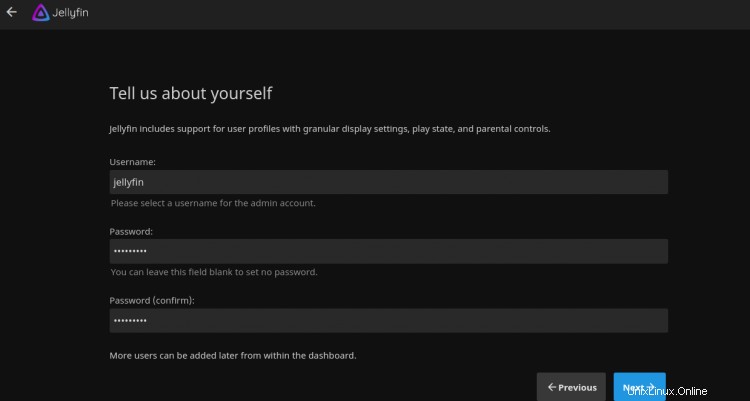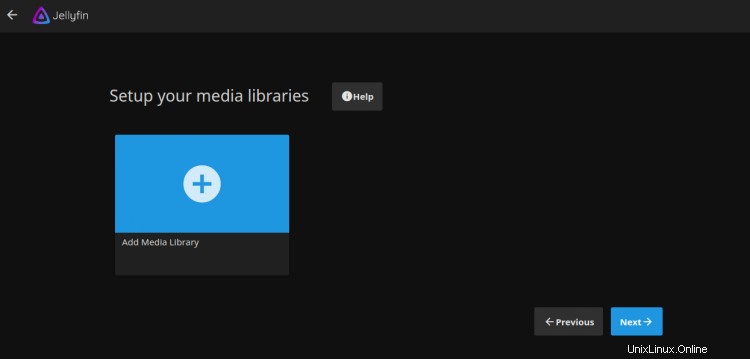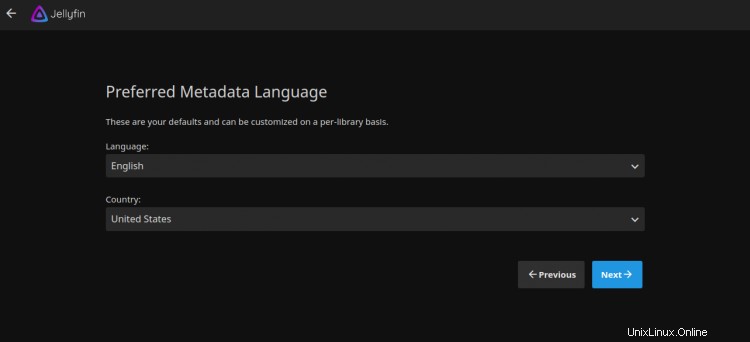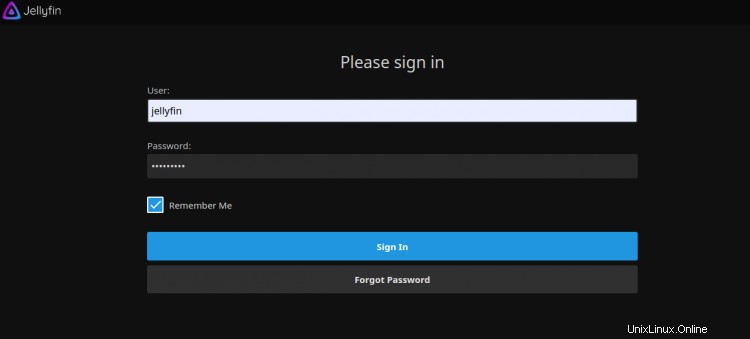Jellyfin è un sistema di streaming multimediale open source che ti consente di gestire e trasmettere in streaming i tuoi file multimediali. È un multipiattaforma e alternativo ad altre applicazioni come Emby e Plex. Con Jellyfin, puoi organizzare e condividere file multimediali, programmi TV, musica e foto dall'interfaccia basata sul Web. Puoi accedere a quei media in streaming sul tuo PC, tablet, telefono, Roku e TV su Internet. Jellyfin recupera automaticamente i metadati dal database di TheMovieDB, OpenMovie, Rotten Tomatoes e TheTVDB.
In questo post, ti mostreremo come installare il server di streaming multimediale Jellyfin con Nginx come proxy inverso su Debian 10.
Prerequisiti
- Un server che esegue Debian 10.
- Un nome di dominio valido puntato all'IP del tuo server.
- Una password di root è configurata sul server.
Per iniziare
Innanzitutto, dovrai aggiornare i pacchetti di sistema con l'ultima versione. Puoi aggiornarli con il seguente comando:
apt-get update -y
Una volta aggiornati tutti i pacchetti, installa altri pacchetti richiesti con il seguente comando:
apt-get install apt-transport-https ca-certificates gnupg2 curl git -y
Una volta installati tutti i pacchetti, puoi procedere al passaggio successivo.
Installa Jellyfin
Per impostazione predefinita, il pacchetto Jellyfin non è incluso nel repository Debian 10. Quindi dovrai aggiungere il repository Jellyfin al tuo APT.
Puoi aggiungerlo con il seguente comando:
echo "deb [arch=$( dpkg --print-architecture )] https://repo.jellyfin.org/debian buster main" | tee /etc/apt/sources.list.d/jellyfin.list
Una volta aggiunto il repository, aggiungi la chiave GPG con il seguente comando:
wget -O - https://repo.jellyfin.org/jellyfin_team.gpg.key | apt-key add -
Quindi, aggiorna il repository e installa Jellyfin con il seguente comando:
apt-get update -y
apt-get install jellyfin -y
Una volta installato Jellyfin, puoi controllare lo stato di Jellyfin con il seguente comando:
systemctl status jellyfin
Dovresti ottenere il seguente output:
? jellyfin.service - Jellyfin Media Server
Loaded: loaded (/lib/systemd/system/jellyfin.service; enabled; vendor preset: enabled)
Drop-In: /etc/systemd/system/jellyfin.service.d
??jellyfin.service.conf
Active: active (running) since Mon 2021-03-22 08:27:42 UTC; 5min ago
Main PID: 10192 (jellyfin)
Tasks: 17 (limit: 4701)
Memory: 113.9M
CGroup: /system.slice/jellyfin.service
??10192 /usr/bin/jellyfin --webdir=/usr/share/jellyfin/web --restartpath=/usr/lib/jellyfin/restart.sh --ffmpeg=/usr/lib/jellyfin-ffm
Mar 22 08:27:45 debian10 jellyfin[10192]: [08:27:45] [WRN] 127.0.0.1/32: GetBindInterface: Loopback 127.0.0.1 returned.
Mar 22 08:27:45 debian10 jellyfin[10192]: [08:27:45] [INF] Executed all pre-startup entry points in 0:00:00.1545678
Mar 22 08:27:45 debian10 jellyfin[10192]: [08:27:45] [INF] Core startup complete
Mar 22 08:27:46 debian10 jellyfin[10192]: [08:27:46] [INF] Executed all post-startup entry points in 0:00:00.1976994
Mar 22 08:27:46 debian10 jellyfin[10192]: [08:27:46] [INF] Startup complete 0:00:03.6985068
Mar 22 08:27:48 debian10 jellyfin[10192]: [08:27:48] [INF] StartupTrigger fired for task: Update Plugins
Mar 22 08:27:48 debian10 jellyfin[10192]: [08:27:48] [INF] Queuing task PluginUpdateTask
Mar 22 08:27:48 debian10 jellyfin[10192]: [08:27:48] [INF] Executing Update Plugins
Mar 22 08:27:49 debian10 jellyfin[10192]: [08:27:49] [INF] Update Plugins Completed after 0 minute(s) and 0 seconds
Mar 22 08:27:49 debian10 jellyfin[10192]: [08:27:49] [INF] ExecuteQueuedTasks
A questo punto Jellyfin è avviato ed è in ascolto sulla porta 8096. Puoi verificarlo con il seguente comando:
ss -antpl | grep 8096
Uscita:
LISTEN 0 128 0.0.0.0:8096 0.0.0.0:* users:(("jellyfin",pid=10192,fd=289))
Configura Nginx come proxy inverso
Successivamente, dovrai configurare Nginx come proxy inverso per accedere a Jellyfin sulla porta 80.
Innanzitutto, installa il pacchetto Nginx con il seguente comando:
apt-get install nginx -y
Una volta installato, crea un nuovo file di configurazione Nginx con il seguente comando:
nano /etc/nginx/conf.d/jellyfin.conf
Aggiungi le seguenti righe:
server {
listen 80;
server_name jellyfin.example.com;
access_log /var/log/nginx/jellyfin.access;
error_log /var/log/nginx/jellyfin.error;
set $jellyfin 127.0.0.1;
location / {
proxy_pass http://127.0.0.1:8096;
proxy_set_header Host $host;
proxy_set_header X-Real-IP $remote_addr;
proxy_set_header X-Forwarded-For $proxy_add_x_forwarded_for;
proxy_set_header X-Forwarded-Proto $scheme;
proxy_set_header X-Forwarded-Protocol $scheme;
proxy_set_header X-Forwarded-Host $http_host;
# Disable buffering when the nginx proxy gets very resource heavy upon streaming
proxy_buffering off;
}
# location block for /web - This is purely for aesthetics so /web/#!/ works instead of having to go to /web/index.html/#!/
location ~ ^/web/$ {
# Proxy main Jellyfin traffic
proxy_pass http://$jellyfin:8096/web/index.html/;
proxy_set_header Host $host;
proxy_set_header X-Real-IP $remote_addr;
proxy_set_header X-Forwarded-For $proxy_add_x_forwarded_for;
proxy_set_header X-Forwarded-Proto $scheme;
proxy_set_header X-Forwarded-Protocol $scheme;
proxy_set_header X-Forwarded-Host $http_host;
}
location /socket {
# Proxy Jellyfin Websockets traffic
proxy_pass http://$127.0.0.1:8096;
proxy_http_version 1.1;
proxy_set_header Upgrade $http_upgrade;
proxy_set_header Connection "upgrade";
proxy_set_header Host $host;
proxy_set_header X-Real-IP $remote_addr;
proxy_set_header X-Forwarded-For $proxy_add_x_forwarded_for;
proxy_set_header X-Forwarded-Proto $scheme;
proxy_set_header X-Forwarded-Protocol $scheme;
proxy_set_header X-Forwarded-Host $http_host;
}
# Security / XSS Mitigation Headers
add_header X-Frame-Options "SAMEORIGIN";
add_header X-XSS-Protection "1; mode=block";
add_header X-Content-Type-Options "nosniff";
}
Salva e chiudi il file, quindi verifica Nginx per eventuali errori di sintassi con il seguente comando:
nginx -t
Uscita:
nginx: the configuration file /etc/nginx/nginx.conf syntax is ok nginx: configuration file /etc/nginx/nginx.conf test is successful
Quindi, riavvia il servizio Nginx per applicare le modifiche:
systemctl reload nginx
Accedi a Jellyfin
Ora apri il tuo browser web e accedi all'interfaccia web di Jellyfin utilizzando l'URL http://jellyfin.example.com . Verrai reindirizzato alla seguente pagina:

Seleziona la tua lingua e fai clic su Avanti pulsante. Dovresti vedere la seguente pagina:

Fornisci il tuo nome utente, password e fai clic su Avanti pulsante. Dovresti vedere la seguente pagina:

Fare clic su Avanti pulsante. Dovresti vedere la seguente pagina:

Seleziona la lingua dei metadati e fai clic su Avanti pulsante. Dovresti vedere la seguente pagina:

Consenti l'accesso remoto e fai clic su Avanti pulsante. Una volta terminata l'installazione, dovresti vedere la seguente pagina:

Fai clic su Fine pulsante per terminare l'installazione. Dovresti vedere la pagina di accesso di Jellyfin:

Fornisci il tuo nome utente, password e fai clic su Firma In pulsante. Dovresti vedere la dashboard di Jellyfin nella pagina seguente:

Proteggi Jellyfin con Let's Encrypt SSL
Successivamente, dovrai installare il pacchetto client Certbot per installare la gestione di Let's Encrypt SSL. Innanzitutto, installa Certbot con il seguente comando:
apt-get install python3-certbot-nginx -y
Al termine dell'installazione, esegui il comando seguente per installare Let's Encrypt SSL sul tuo sito Web:
certbot --nginx -d jellyfin.example.com
Ti verrà chiesto di fornire un indirizzo email valido e di accettare i termini del servizio come mostrato di seguito:
Saving debug log to /var/log/letsencrypt/letsencrypt.log Plugins selected: Authenticator nginx, Installer nginx Enter email address (used for urgent renewal and security notices) (Enter 'c' to cancel): [email protected] - - - - - - - - - - - - - - - - - - - - - - - - - - - - - - - - - - - - - - - - Please read the Terms of Service at https://letsencrypt.org/documents/LE-SA-v1.2-November-15-2017.pdf. You must agree in order to register with the ACME server at https://acme-v02.api.letsencrypt.org/directory - - - - - - - - - - - - - - - - - - - - - - - - - - - - - - - - - - - - - - - - (A)gree/(C)ancel: A - - - - - - - - - - - - - - - - - - - - - - - - - - - - - - - - - - - - - - - - Would you be willing to share your email address with the Electronic Frontier Foundation, a founding partner of the Let's Encrypt project and the non-profit organization that develops Certbot? We'd like to send you email about our work encrypting the web, EFF news, campaigns, and ways to support digital freedom. - - - - - - - - - - - - - - - - - - - - - - - - - - - - - - - - - - - - - - - - (Y)es/(N)o: Y Obtaining a new certificate Performing the following challenges: http-01 challenge for jellyfin.example.com Waiting for verification... Cleaning up challenges Deploying Certificate to VirtualHost /etc/nginx/conf.d/jellyfin.conf
Quindi, scegli se reindirizzare o meno il traffico HTTP su HTTPS come mostrato di seguito:
- - - - - - - - - - - - - - - - - - - - - - - - - - - - - - - - - - - - - - - - 1: No redirect - Make no further changes to the webserver configuration. 2: Redirect - Make all requests redirect to secure HTTPS access. Choose this for new sites, or if you're confident your site works on HTTPS. You can undo this change by editing your web server's configuration. - - - - - - - - - - - - - - - - - - - - - - - - - - - - - - - - - - - - - - - - Select the appropriate number [1-2] then [enter] (press 'c' to cancel): 2
Digita 2 e premi Invio per completare l'installazione. Dovresti vedere il seguente output:
Redirecting all traffic on port 80 to ssl in /etc/nginx/conf.d/jellyfin.conf - - - - - - - - - - - - - - - - - - - - - - - - - - - - - - - - - - - - - - - - Congratulations! You have successfully enabled https://jellyfin.example.com You should test your configuration at: https://www.ssllabs.com/ssltest/analyze.html?d=jellyfin.example.com - - - - - - - - - - - - - - - - - - - - - - - - - - - - - - - - - - - - - - - - IMPORTANT NOTES: - Congratulations! Your certificate and chain have been saved at: /etc/letsencrypt/live/jellyfin.example.com/fullchain.pem Your key file has been saved at: /etc/letsencrypt/live/jellyfin.example.com/privkey.pem Your cert will expire on 2020-10-30. To obtain a new or tweaked version of this certificate in the future, simply run certbot again with the "certonly" option. To non-interactively renew *all* of your certificates, run "certbot renew" - Your account credentials have been saved in your Certbot configuration directory at /etc/letsencrypt. You should make a secure backup of this folder now. This configuration directory will also contain certificates and private keys obtained by Certbot so making regular backups of this folder is ideal. - If you like Certbot, please consider supporting our work by: Donating to ISRG / Let's Encrypt: https://letsencrypt.org/donate Donating to EFF: https://eff.org/donate-le - We were unable to subscribe you the EFF mailing list because your e-mail address appears to be invalid. You can try again later by visiting https://act.eff.org.
Ora, il tuo sito web è protetto con Let's Encrypt SSL. Puoi accedervi in modo sicuro utilizzando l'URL https://jellyfin.example.com.
Conclusione
Congratulazioni! hai installato con successo Jellyfin sul server Debian 10. Ora puoi condividere facilmente i tuoi file multimediali con i tuoi amici, familiari e altri utenti.